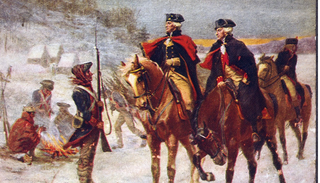Confidence
America's Bleakest Christmas
Discouraged this holiday season? America has seen worse.
Posted December 23, 2019
When George Washington’s American revolutionary war troops marched into Valley Forge, Pennsylvania, on December 19, 1777, the Continental Army and its commander’s standing were in dire shape. Christmas that year would prove bleak indeed. The next few dark months would take more American lives than any battle Washington’s force of 12,000 would fight.
Although the situation appeared dire, the lessons learned there would restore confidence and respect for both the American fighting force and its commander, laying the groundwork for eventual American victory.

Valley Forge
Washington and his commanders chose Valley Forge because it was near enough to Philadelphia (20 miles) to keep an eye on the superior British forces wintering there but sufficiently distant to defend against a surprise attack.
As soon as the American troops arrived, they set about building nearly 2,000 wood huts on the productive farmland. The troops quickly constructed an open-ground encampment whose population would rival all but the largest colonial cities of the day. But it was a population in grave distress.
A crisis of confidence
Confidence was desperately low in Washington and his men. King George had sent a large fleet, eventually amassing an army of 48,000 troops to quell the colonial rebellion, and the British had routed the Continental Army and captured the capital of Philadelphia in September. Founders such as John Adams and Benjamin Rush expressed grave doubts about Washington’s ability to turn the course of the war.
Adams, who nominated Washington as commander in 1775 and would later serve as his vice president and successor as the nation’s second president, had developed more confidence in General Horatio Gates, who had won an important victory over the British at Saratoga at the same time Washington seemed to be suffering defeat after defeat.
Desperate conditions
At Valley Forge, the troops’ battle readiness was sorely undermined by poor provisioning. Even necessities such as clothing, blankets, and food were often in short supply. Perhaps 1,000 soldiers deserted, and Washington wrote to Congress that, “We have made no less than 2,898 men now in camp unfit for duty because they are barefoot and otherwise naked.”
Washington became a tireless advocate for more support—money, food, supplies—for his men. He wrote in February 1778:
"For some days past there has been little less than a famine in camp. A part of the army has been a week without any kind of flesh and the rest for three or four days. Naked and starving as they are, we cannot enough admire the incomparable patience and fidelity of the soldiery that they have not been excited to a general mutiny or dispersion."
Lack of public support
Exacerbating the supply problems was the fact that Washington could pay for supplies only with notes, while the British could offer hard currency. As a result, much of the food around Philadelphia found its way to the Red Coats stationed there. Regardless of where farmers’ loyalties lay, few could afford to sell at a loss, even less give their goods to the troops.
Further compounding the problem was Washington’s reluctance to publicize the condition of his troops, for fear that it might whet the enemy’s appetite for an attack. As a result, most of the public knew nothing of the army’s desperate condition. Some even resented the troops, who seemed to be collecting their pay without doing any fighting for months on end.
The ravages of disease
More American troops died at Valley Forge than in any battle fought during the revolutionary war—about 2,000. They were living in cramped quarters, poor hygiene and sanitation were the rule, and conditions were nearly ideal for the transmission of diseases such as influenza, typhus, and dysentery. Recognizing the threat to morale, Washington directed that hospitals, the site of most deaths, be erected at a distance.
Perhaps the one bright spot in infectious disease at Valley Forge came with smallpox. Inoculation with a milder form of smallpox could prevent severe forms of the disease. Washington ordered mass inoculations, which rendered thousands of soldiers immune, representing what came to be known as “the first large-scale, state-sponsored immunization campaign in history.”
Transforming the fighting force
Yet all was not lost. On the recommendation of Benjamin Franklin, a Prussian military officer arrived in Valley Forge in February 1778. His name was Friedrich von Steuben. Upon his arrival, he established new sanitation standards, accurate bookkeeping on supplies, and regular inspections. He began drilling the troops twice each day, and his high bearing and multilingual profanity quickly endeared him to the troops.
Steuben served as Washington’s chief of staff through the war’s end, along the way drafting a training manual that served the US military until the War of 1812. It educated generations of soldiers on discipline and tactics. When British forces reengaged the Continental Army in the summer of 1778, they were surprised to discover that the Americans had been transformed into a far more effective fighting force.
Respect for diversity
Among those encamped at Valley Forge, diversity was incredibly high. About 30% of soldiers were not native English speakers, German being the second most common language. Black soldiers are thought to have made up about 10% of Washington’s force. It marked the last time US soldiers were not segregated by race until the Korean War.
In addition, Baron von Steuben, perhaps the most indispensable man at Valley Forge save Washington, seems to have preferred the intimate company of men. Rumors about his sexuality did not deter Washington, who wrote: “He appears to be much of a gentleman, and as far as I have had an opportunity of judging, a man of military knowledge, and acquainted with the world.”
French alliance
Some of the most important efforts to advance the revolutionary cause were taking place not at Valley Forge but across the ocean in France. Benjamin Franklin, one of the most brilliant men of his day, had in 1776 been appointed ambassador to France on behalf of the 13 colonies. Thanks to Franklin, the US concluded a French military alliance in February 1778, dramatically increasing prospects for victory.
Franklin’s diplomacy secured crucial terms. For example, neither France nor the United States would agree to a separate peace with the British, and American independence would be a condition for any peace agreement. The agreement proved an extravagance for the French, but the support of their fleet countered British naval dominance and shifted the balance of the war.
From despair to redemption
As the story of Valley Forge indicates, America has faced some pretty bleak Christmases. Loss of confidence in leaders, the plight of the dispossessed, public discord, and disasters of one sort or another have all taken their toll. Yet, through renewed vision and dedication, welcoming new ideas and people, and forming new alliances, Americans have rebounded and lighted the way for brighter Yuletides ahead.




